PicoScope 3000D USB oscilloscope series from 50 MHz to 200 MHz
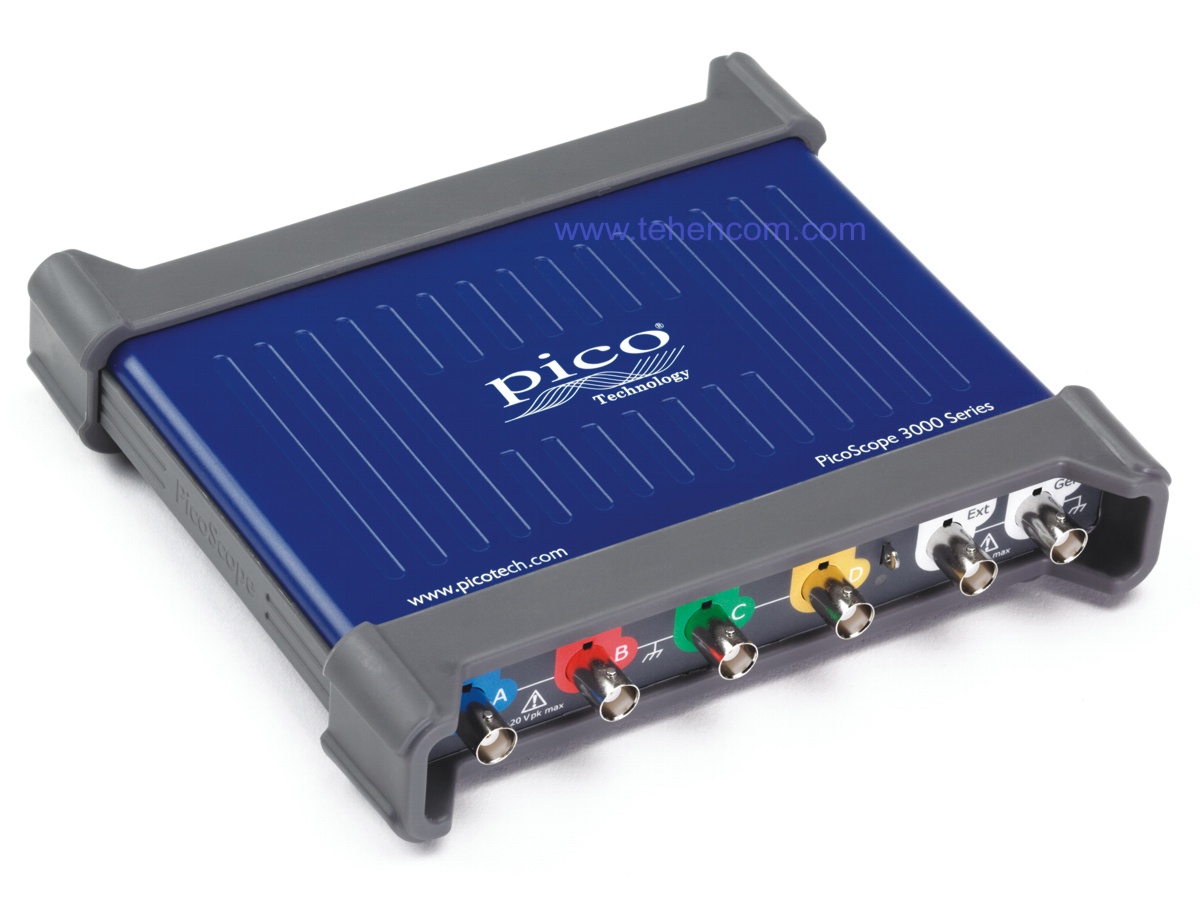
Product code: 1000413
Add item to cart. Our specialist will coordinate with you the complete set, tell you the price and delivery time.
From 32 304 UAH
SHORT DESCRIPTION
USB Oscilloscope Series PicoScope 3000D companies Pico Technology (Great Britain) by the totality of characteristics refers to digital oscilloscopes of the middle level. The hardware of these compact instruments is comparable to desktop laboratory oscilloscopes of a similar class, and in terms of built-in memory and waveform capture speed, they significantly outperform most of their competitors.
The PicoScope 3000D series consists of sixteen models that differ in bandwidth (from 50 MHz to 200 MHz), the number of analog channels (2 or 4) and the presence of a built-in logic analyzer for 16 digital channels (present in models with the MSO suffix). You can download a full description of all the characteristics of these oscilloscopes below on this page in the section Documentation.
Key Features of Pico Technology PicoScope 3000D Series:
50 MHz, 1 GS/s, 2 channels (PicoScope 3203D).
50 MHz, 1 GS/s, 4 channels (PicoScope 3403D).
70 MHz, 1 GS/s, 2 channels (PicoScope 3204D).
70 MHz, 1 GS/s, 4 channels (PicoScope 3404D).
100 MHz, 1 GS/s, 2 channels (PicoScope 3205D).
100 MHz, 1 GS/s, 4 channels (PicoScope 3405D).
200 MHz, 1 GS/s, 2 channels (PicoScope 3206D).
200 MHz, 1 GS/s, 4 channels (PicoScope 3406D).
50 MHz, 1 GS/s, 2 channels + 16 digital channels (PicoScope 3203D MSO).
50 MHz, 1 GS/s, 4 channels + 16 digital channels (PicoScope 3403D MSO).
70 MHz, 1 GS/s, 2 channels + 16 digital channels (PicoScope 3204D MSO).
70 MHz, 1 GS/s, 4 channels + 16 digital channels (PicoScope 3404D MSO).
100 MHz, 1 GS/s, 2 channels + 16 digital channels (PicoScope 3205D MSO).
100 MHz, 1 GS/s, 4 channels + 16 digital channels (PicoScope 3405D MSO).
200 MHz, 1 GS/s, 2 channels + 16 digital channels (PicoScope 3206D MSO).
200 MHz, 1 GS/s, 4 channels + 16 digital channels (PicoScope 3406D MSO).
If two or more channels are active, then the sampling rate is reduced (see the table in the documentation).
Recording length (total, depends on the model): 64M to 512M.
Vertical resolution: 8 bits (up to 12 bits). Sensitivity: 4 mV/div to 4 V/div.
Continuous waveform capture rate (DPO mode): before 100,000 waveforms/s.
All models include a built-in standard and arbitrary waveform generator (12 bit AWG).
All models support decoding and analysis of 18 serial protocols: I2C, I2S, SPI, CAN, LIN, 1-Wire, RS-232/UART, USB 1.1, Ethernet, FlexRay and others.
15 automatic measurements, FFT analysis (FFT), mathematical signal processing.
Powerful PicoScope 6 software (in Russian) included in the scope of delivery.
Interfaces: USB 3 (it is possible to connect to USB 2 with a special cable).
Weight: 0.5 kg. Dimensions: 190 x 170 x 40 mm. Working temperature: from 0°С to +40°С.
Large memory, digital phosphor, protocol analyzer, generator
Need USB oscilloscope with bandwidth up to 500 MHz? Watch the series PicoScope 6000E.
Need USB oscilloscope easier and cheaper? See series PicoScope 2000A and 2000B.
Need to measure conventional signals and radio signals? Watch the series Tektronix MDO3.
Difficult to decide on a model? See the guide: How to quickly choose an oscilloscope.
All series of modern oscilloscopes are presented here:
Digital oscilloscopes.
DETAILED DESCRIPTION
Pico Technology's oscilloscopes compare favorably with their competitors in that all possible functionality is immediately included in the scope of delivery of the device and it does not need to be purchased for additional money.
Among the professional features that are available in any model of the PicoScope 3000D series, deserve special attention: huge built-in memory (up to 512 million samples) with the possibility of segmentation, digital phosphor DPO (100,000 waveforms/s), serial bus decoding (18 protocols), built-in generator standard and arbitrary waveforms (12-bit AWG), mask testing, and more. Also available in MSO models logic analyzer for 16 digital channels.
In addition to the impressive functionality received at the start, you will be able to receive new functions for free during the entire period of using your PicoScope 3000D, which are periodically added by Pico Technology as a control software PicoScope 6, and in the firmware of the oscilloscope itself.
This photo shows the appearance of the PicoScope 3000D series compact 4-channel USB oscilloscope running a laptop with the PicoScope 6 software installed, which is included as standard.
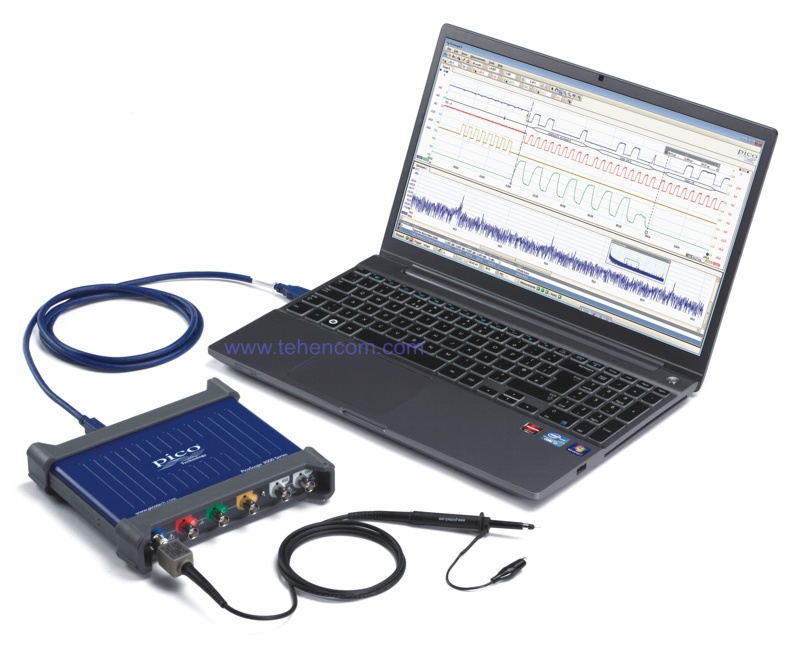
Unparalleled Waveform Experience in PicoScope 6
PicoScope 3000D USB oscilloscopes can be controlled and measured using the PC software PicoScope 6. This provides a significant advantage when working with many analog and digital signals, since a large computer monitor can accommodate much more information than a small screen of a comparable class of stationary oscilloscope. In the PicoScope 6 software settings, you can select Russian user interface.
The screenshot below shows an example of the window of the PicoScope 6 control program. Pay attention to how much information is simultaneously present on the screen and how clearly the smallest signal details and text digital values are visible.
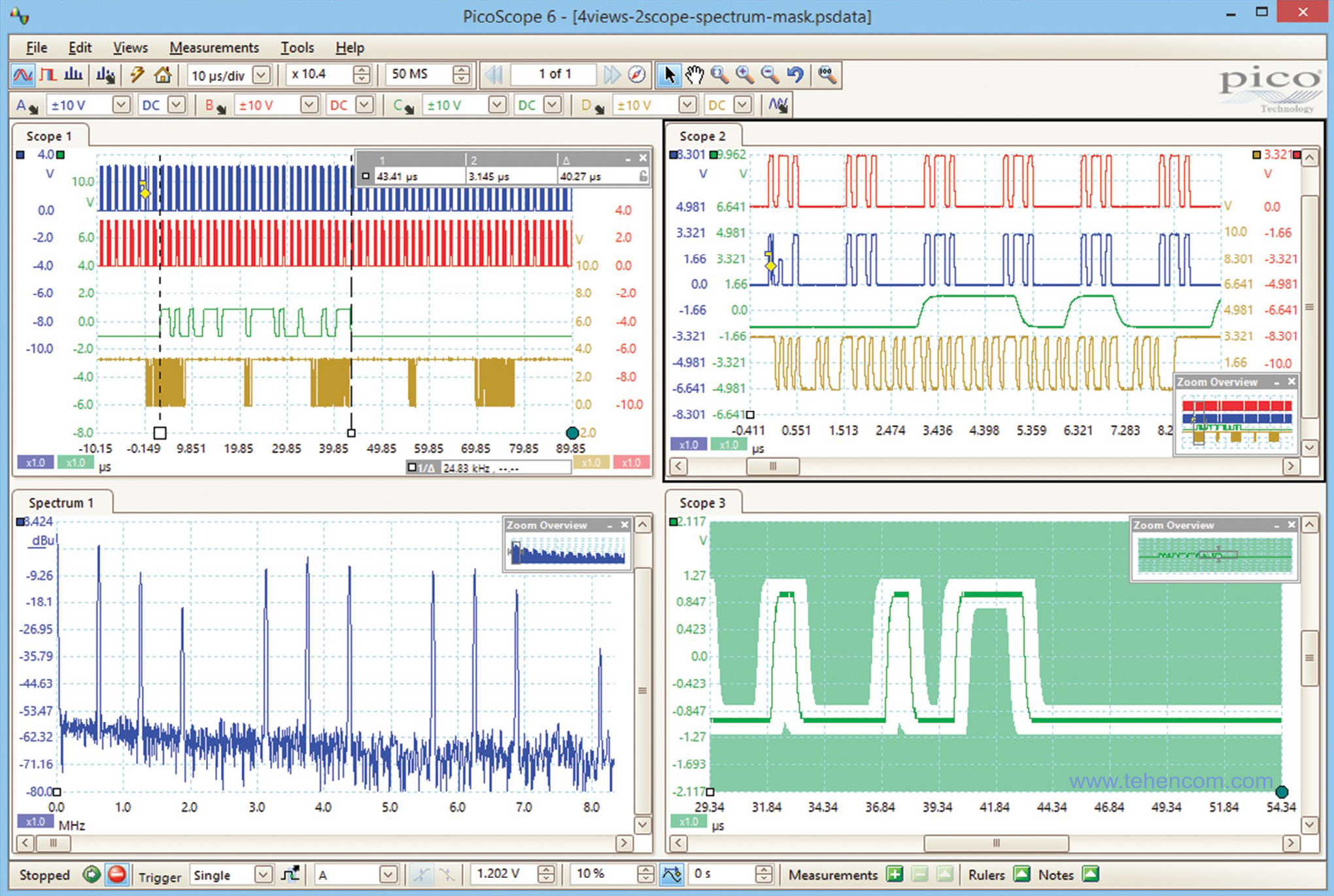
PicoScope 6 supports even large monitors such as Ultra HD 4K (3840 by 2160 pixels). You can work with a large number of signals at the same time, observing them in amazing detail. The signal of the same channel can be viewed in several windows, using in each of them its own scale parameters, its own set of markers and any other settings supported by the program.
Using a familiar computer keyboard and mouse makes it much easier to enter numerical values and work with tabular data, for example, with the results of decoding the logical states of parallel digital buses or serial protocols. And saving measurements directly to a computer disk is much faster and more convenient than transferring files from a desktop oscilloscope using a USB flash drive.
Huge amount of built-in memory of PicoScope 3000D oscilloscopes
All PicoScope 3000D series USB oscilloscopes contain a huge amount of internal memory for their class. Depending on the oscilloscope model, it can store up to 64 Msample in internal memory up to 512 million samples. This makes it possible to record and analyze very long signals.
For example, this screenshot shows a 10 second continuous waveform recording (located on the Scope 1 tab). The other three tabs (Scope 2, 3 and 4) display an enlarged fragment of the same signal with a magnification of 256, 130,000 and 2,000,000 times. This is a very useful feature when working with non-periodic signals and when looking for anomalies in long digital sequences, such as glitches or runts.
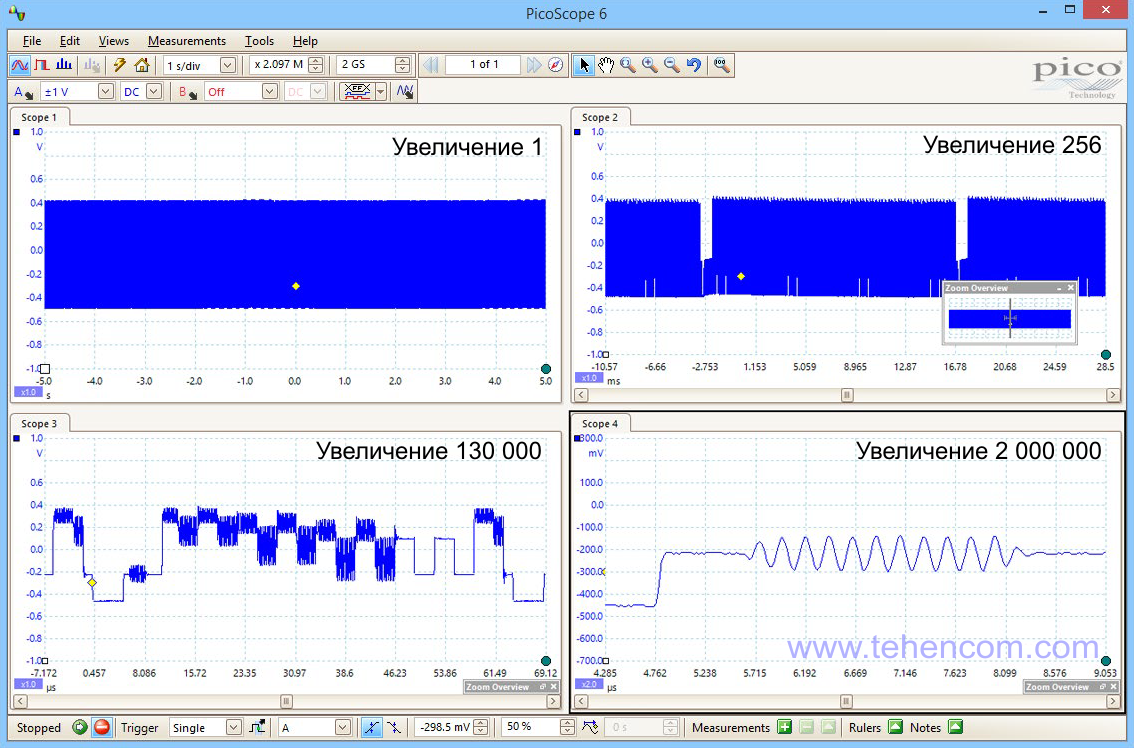
The capabilities provided by the large internal memory of the PicoScope 3000D oscilloscopes are further enhanced by the presence hardware segmentation of this memory. In segmentation mode, the entire amount of internal memory is divided into separate parts (maximum 10,000 segments). With each trigger event, the signal is digitized and stored in its segment with the exact time stamp stored, and the minimum time between two separate triggers can be as little as 700 ns.
By storing up to 10,000 waveforms in memory in this way, you can perform a manual or automatic search for various signal anomalies among them, for example, by comparing its shape with a specific mask (template). The window for manually selecting a saved segment is shown in this screenshot. Below it is a graphic illustration of the principle of operation of segmented memory into 100 segments.
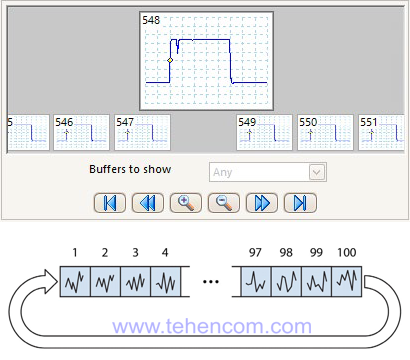
Many oscilloscope models equipped with large built-in memory are not able to effectively interact with it. Searching this memory takes a long time and the screen refreshes slowly. This is because the oscilloscope's microprocessor does not have enough processing power to rapidly process the millions of samples stored in memory.
PicoScope 3000D USB oscilloscopes have a special HAL3 hardware accelerator, which is entirely responsible for interacting with their large built-in memory. With the HAL3 accelerator, PicoScope 3000D oscilloscopes can capture, store, process, and display over 440,000,000 samples per second on a computer screen.
As an example, this screenshot shows two plots of the same 2 second waveform with 2,000,000 samples. The signal contains two very short dips. The upper graph is built with the HAL3 hardware accelerator enabled, and the lower graph is disabled. On the upper graph, the HAL3 accelerator instantly processed all 2,000,000 samples, found and correctly displayed all events. In the lower graph, these two important signal changes are completely absent.
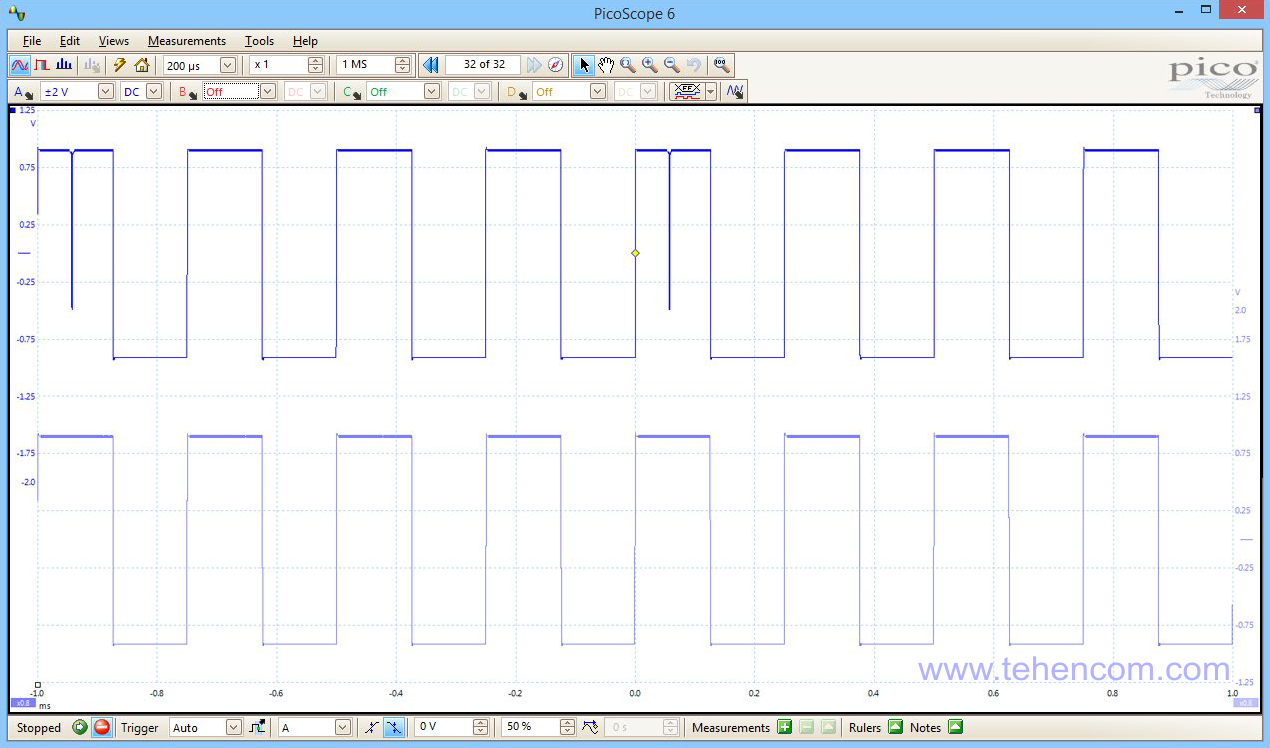
DPO Digital Phosphor Technology (Rare Event Detection and Visualization)
In this mode, the PicoScope 3000D Series digitizes and displays up to 100,000 waveforms per second, superimposing them one on top of the other and highlighting with brighter colors those areas of the screen where the signal occurs most often. Such a high speed of processing and visualization of oscillograms became possible thanks to the HAL3 hardware accelerator built into the oscilloscope.
The digital phosphor mode is great for finding rare anomalies (glitches, runts, timing failures), for detecting floating amplitude or frequency of a signal, measuring jitter, and also for checking whether a signal matches a given mask. You can read more about this mode in a special article: DPO digital phosphor technology.
This screenshot shows the operation of the digital phosphor function, which is called Persistence mode in Pico Technology's documentation. Red and yellow colors show places where a signal is more often detected, and shades of blue show places where a signal is rarely detected.
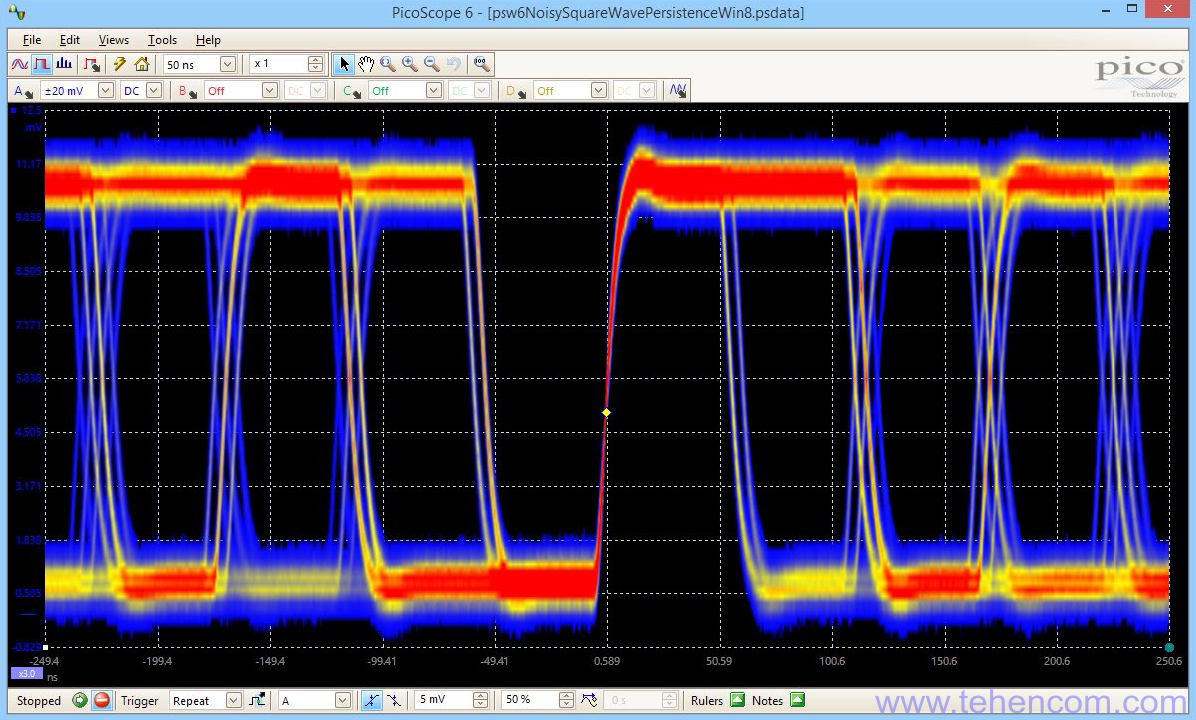
Decoding and analysis of serial protocols
Decoding and analysis of serial bus signals is an integral part of the development and debugging of many electronic devices. PicoScope 3000D Series Oscilloscopes as standard can work with the following serial protocols: I2C, I2S, SPI, UART/RS-232, PS/2, CAN, LIN, 1-Wire, SENT Fast and Slow, Ethernet 10Base-T and 100Base-TX, FlexRay, ARINC 429, DCC, DMX512 and USB 1.1. For many other oscilloscope models, this functionality must be purchased, and for the PicoScope 3000D series, it is absolutely free.
PicoScope 3000D MSO models contain 16 digital channels in addition to analog channels, which further expands the decoding capabilities of serial protocols due to the increased number of connection points. Thus the MSO models have possibility of simultaneous analysis multiple serial bus signals.
An example of car serial CAN decoding is shown in this screenshot. The top of the screen shows the CAN serial data signal, and the bottom shows a very detailed table of decoded values, including data, CRC, timestamps, etc.
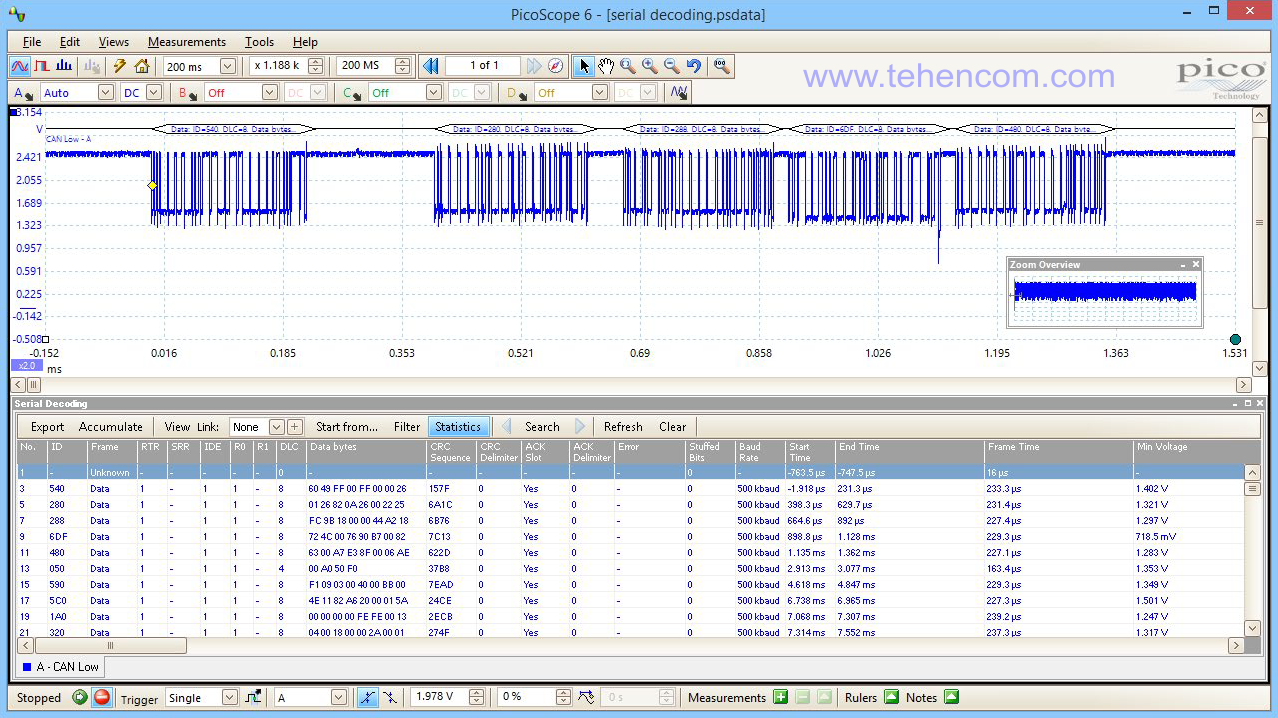
Generator of standard and arbitrary signals
All PicoScope 3000D Series oscilloscopes include a built-in standard and arbitrary waveform generator with a maximum amplitude of -2 V to +2 V.
Standard Signal Generator can be used to generate: sine (up to 1 MHz), rectangle, triangle, constant voltage, rising waveform, falling waveform, sinc function waveform, Gaussian noise, etc.
Arbitrary Signal Generator contains a 12-bit DAC with a refresh rate of 20 MS/s. The data comes from the DAC buffer, 32,000 samples in size. The minimum amplitude of the generated signal step is about 1 mV.
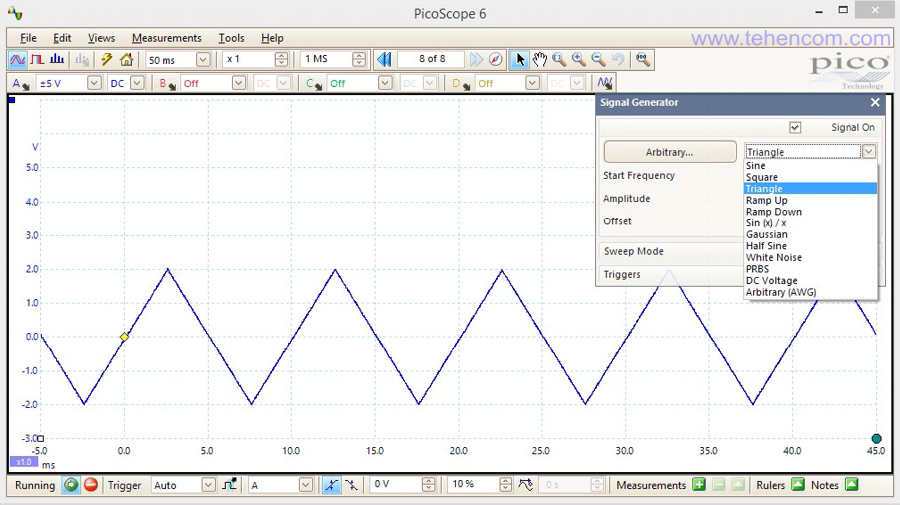
Built-in logic analyzer for 16 channels
Of the sixteen models of the PicoScope 3000D series USB oscilloscopes, eight models contain a built-in logic analyzer with 16 digital channels. These models have the suffix MSO in the name, which stands for Mixed Signal Oscilloscope (mixed signal oscilloscope).
This photo shows the appearance of one of these models. 8 out of 16 digital channels of the oscilloscope and 2 out of 4 analog channels are connected to the prototype under study.
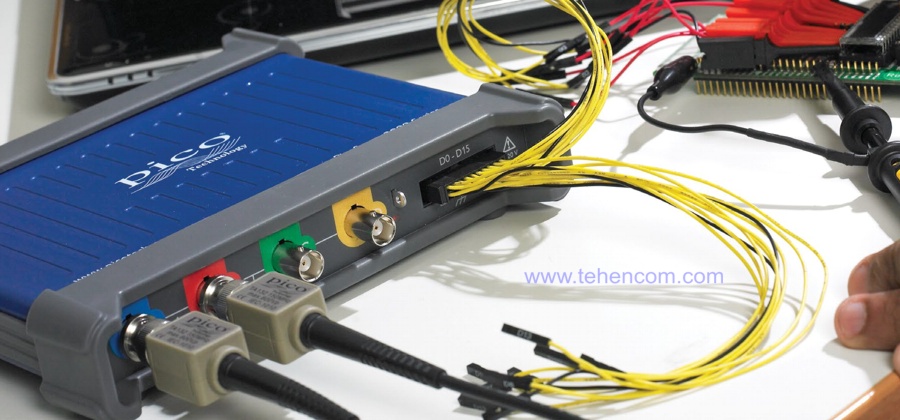
Even if you simultaneously display all the analog and all digital signals that the oscilloscope measures on the computer screen, it is still very convenient to work with them, since modern monitors are great for visualizing large amounts of information.
This screenshot shows an example screen when the oscilloscope has two analog and 16 digital channels active. All signals are visible very well.
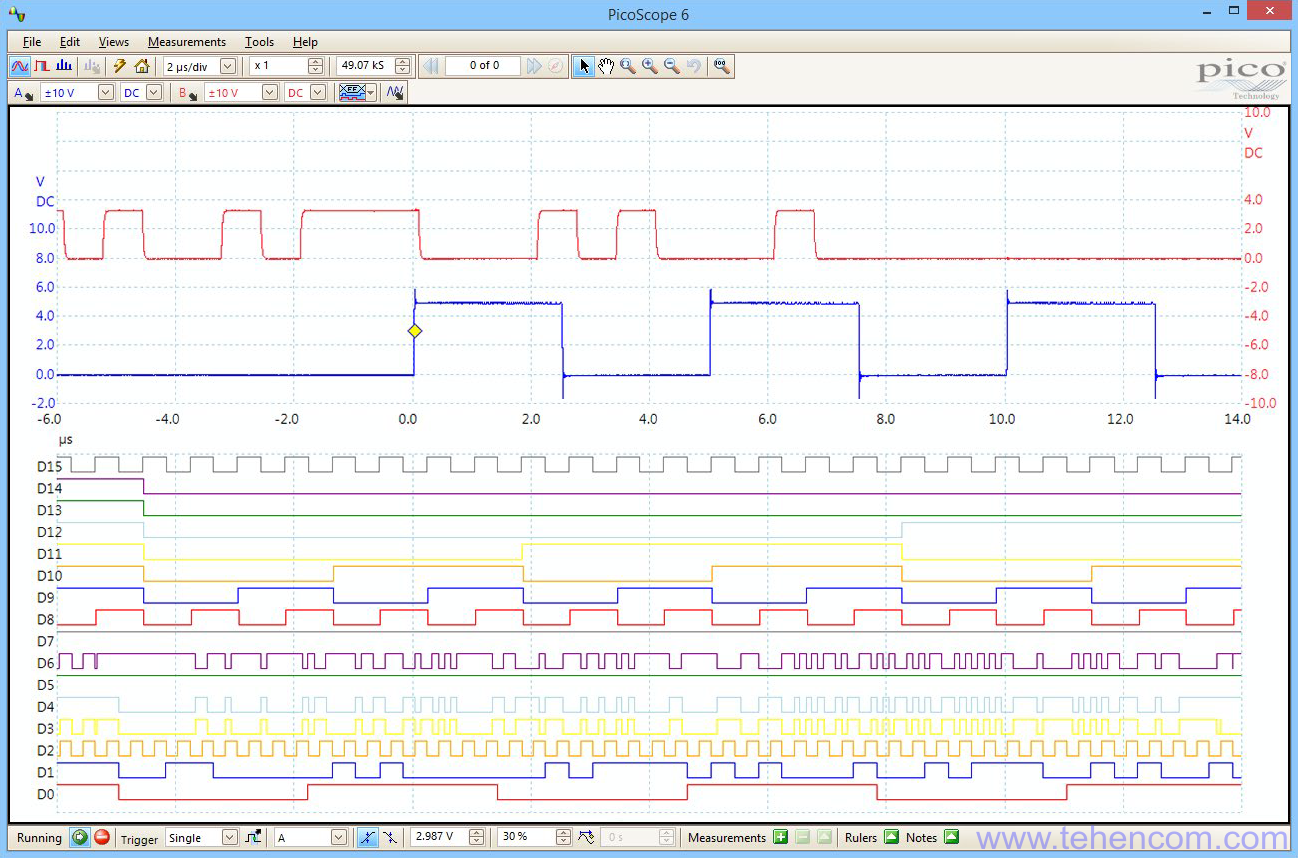
The sixteen digital channels of the PicoScope 3000D MSO are divided into two groups of 8 channels. In the program settings menu for each of these two groups, you can set your own threshold voltage, either by selecting the logic used (TTL, etc.), or by setting any voltage in the range from -5 V to +5 V.
For visualization convenience, signals can be combined into logically related groups and assigned names: I2C, SPI, UART, etc. A screenshot of the corresponding settings menu is shown below.
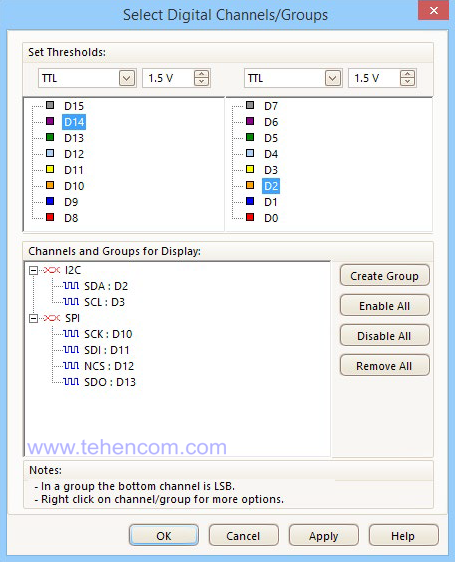
PicoScope 3000D MSO oscilloscopes have a very flexible triggering system. It allows you to set various conditions and their combinations, under which the oscilloscope will record all waveforms in memory and display them on the screen for advanced analysis.
For each digital channel, you can set your own trigger conditions, you can also select several channels and configure triggering when a certain digital combination appears on this group of channels. You can add logical operators if necessary. And you can also combine all these digital trigger conditions with the trigger condition for analog channels.
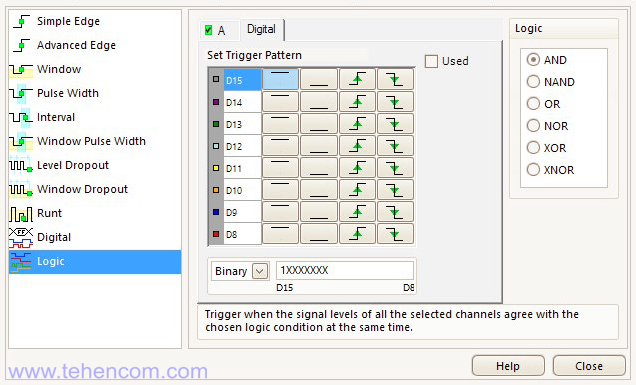
Specifications for Pico Technology PicoScope 3000D Series Oscilloscopes
Here is a list of the main specifications of the PicoScope 3000D series USB oscilloscopes. For detailed technical specifications, see below on this page in the section Documentation.
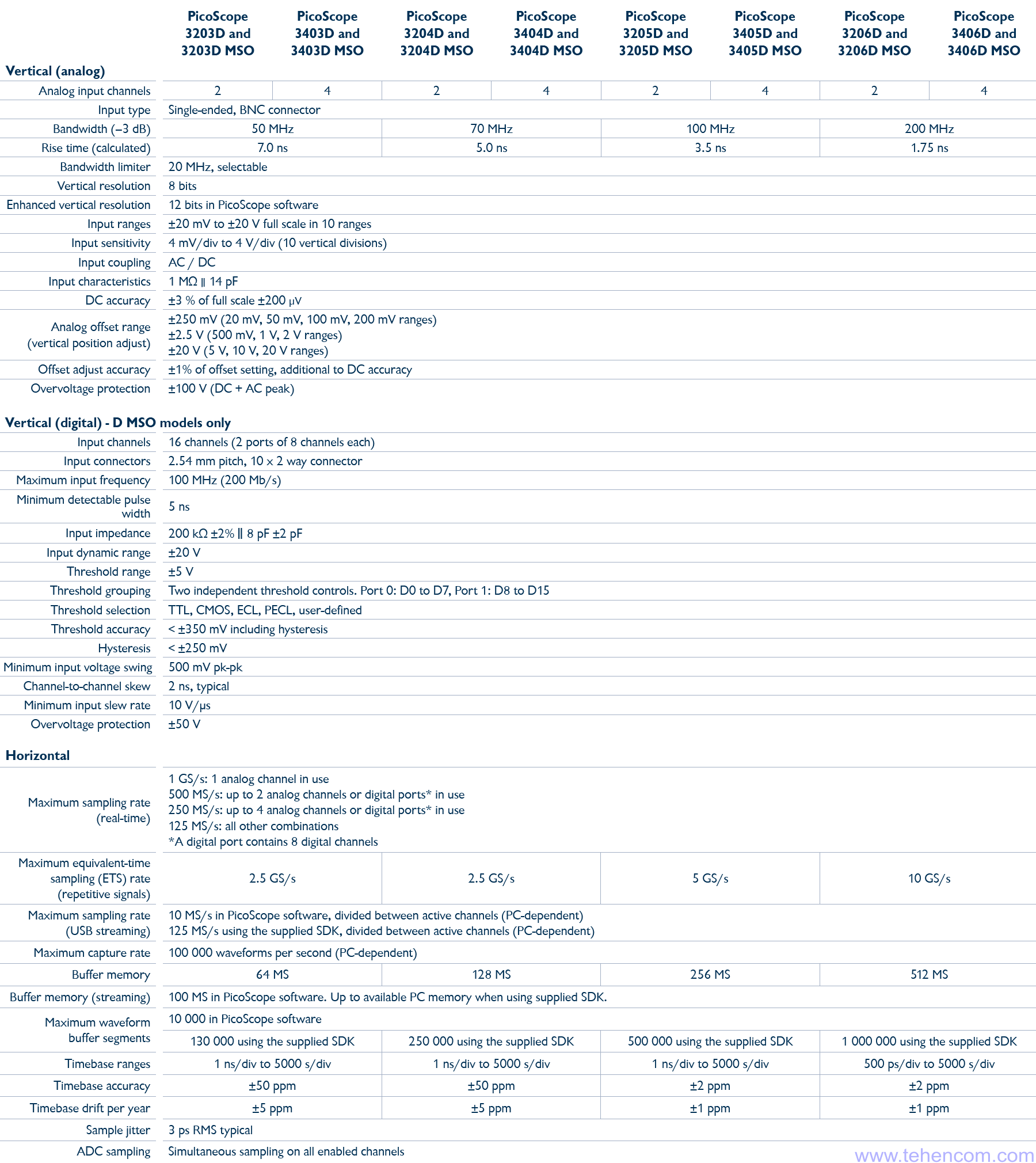
Pico Technology USB oscilloscope PicoScope 3000D series
| Name | Short description |
| Pico Technology PicoScope 3203D |
Digital storage oscilloscope, bandwidth 50 MHz, 2 channels, ADC 8 bits, sampling rate up to 1 GS/s, total record length 64M points. Includes 2 passive probes (60 MHz, 10:1). |
| or | |
| Pico Technology PicoScope 3203D MSO |
Digital storage oscilloscope, bandwidth 50 MHz, 2 channels, ADC 8 bits, sampling rate up to 1 GS/s, 16 digital channels, total recording length 64M points. Includes 2 passive probes (60 MHz, 10:1) and one logic analyzer probe (16 digital channels). |
| or | |
| Pico Technology PicoScope 3403D |
Digital storage oscilloscope, bandwidth 50 MHz, 4 channels, ADC 8 bits, sampling rate up to 1 GS/s, total record length 64M points. Includes 4 passive probes (60 MHz, 10:1). |
| or | |
| Pico Technology PicoScope 3403D MSO |
Digital storage oscilloscope, bandwidth 50 MHz, 4 channels, ADC 8 bits, sampling rate up to 1 GS/s, 16 digital channels, total recording length 64M points. Includes 4 passive probes (60 MHz, 10:1) and one logic analyzer probe (16 digital channels). |
| or | |
| Pico Technology PicoScope 3204D |
Digital storage oscilloscope, bandwidth 70 MHz, 2 channels, ADC 8 bits, sampling rate up to 1 GS/s, total record length 128M points. Includes 2 passive probes (150 MHz, 10:1). |
| or | |
| Pico Technology PicoScope 3204D MSO |
Digital storage oscilloscope, bandwidth 70 MHz, 2 channels, ADC 8 bits, sampling rate up to 1 GS/s, 16 digital channels, total recording length 128M points. Includes 2 passive probes (150 MHz, 10:1) and one logic analyzer probe (16 digital channels). |
| or | |
| Pico Technology PicoScope 3404D |
Digital storage oscilloscope, bandwidth 70 MHz, 4 channels, ADC 8 bits, sampling rate up to 1 GS/s, total record length 128M points. Includes 4 passive probes (150 MHz, 10:1). |
| or | |
| Pico Technology PicoScope 3404D MSO |
Digital storage oscilloscope, bandwidth 70 MHz, 4 channels, ADC 8 bits, sampling rate up to 1 GS/s, 16 digital channels, total recording length 128M points. Includes 4 passive probes (150 MHz, 10:1) and one logic analyzer probe (16 digital channels). |
| or | |
| Pico Technology PicoScope 3205D |
Digital storage oscilloscope, bandwidth 100 MHz, 2 channels, ADC 8 bits, sampling rate up to 1 GS/s, total record length 256M points. Includes 2 passive probes (150 MHz, 10:1). |
| or | |
| Pico Technology PicoScope 3205D MSO |
Digital storage oscilloscope, bandwidth 100 MHz, 2 channels, ADC 8 bits, sampling rate up to 1 GS/s, 16 digital channels, total recording length 256M points. Includes 2 passive probes (150 MHz, 10:1) and one logic analyzer probe (16 digital channels). |
| or | |
| Pico Technology PicoScope 3405D |
Digital storage oscilloscope, bandwidth 100 MHz, 4 channels, ADC 8 bits, sampling rate up to 1 GS/s, total record length 256M points. Includes 4 passive probes (150 MHz, 10:1). |
| or | |
| Pico Technology PicoScope 3405D MSO |
Digital storage oscilloscope, bandwidth 100 MHz, 4 channels, ADC 8 bits, sampling rate up to 1 GS/s, 16 digital channels, total recording length 256M points. Includes 4 passive probes (150 MHz, 10:1) and one logic analyzer probe (16 digital channels). |
| or | |
| Pico Technology PicoScope 3206D |
Digital storage oscilloscope, bandwidth 200 MHz, 2 channels, ADC 8 bits, sampling rate up to 1 GS/s, total record length 512M points. Includes 2 passive probes (250 MHz, 10:1). |
| or | |
| Pico Technology PicoScope 3206D MSO |
Digital storage oscilloscope, bandwidth 200 MHz, 2 channels, ADC 8 bits, sampling rate up to 1 GS/s, 16 digital channels, total recording length 512M points. Includes 2 passive probes (250 MHz, 10:1) and one logic analyzer probe (16 digital channels). |
| or | |
| Pico Technology PicoScope 3406D |
Digital storage oscilloscope, bandwidth 200 MHz, 4 channels, ADC 8 bits, sampling rate up to 1 GS/s, total record length 512M points. Includes 4 passive probes (250 MHz, 10:1). |
| or | |
| Pico Technology PicoScope 3406D MSO |
Digital storage oscilloscope, bandwidth 200 MHz, 4 channels, ADC 8 bits, sampling rate up to 1 GS/s, 16 digital channels, total recording length 512M points. Includes 4 passive probes (250 MHz, 10:1) and one logic analyzer probe (16 digital channels). |
| a plus: | |
| - | USB 3.0 cable (1.8 meters) |
| - | 5V power supply (only for 4-channel models) |
| - | Quick start-up and safety guide |
| - | CD with Russified PicoScope 6 software for USB oscilloscope control |
| - | 1 year warranty (can be extended to 3 and 5 years) |
The standard delivery package of the PicoScope 3000D series four-channel digital oscilloscopes is shown in the photo below. Dual channel models come with two probes instead of four and no power supply as dual channel models are USB powered. MSO models are optionally equipped with a logic analyzer probe for 16 digital channels.
For a list of additional accessories that can be supplied with these oscilloscopes, see below on this page in the section Options and accessories.
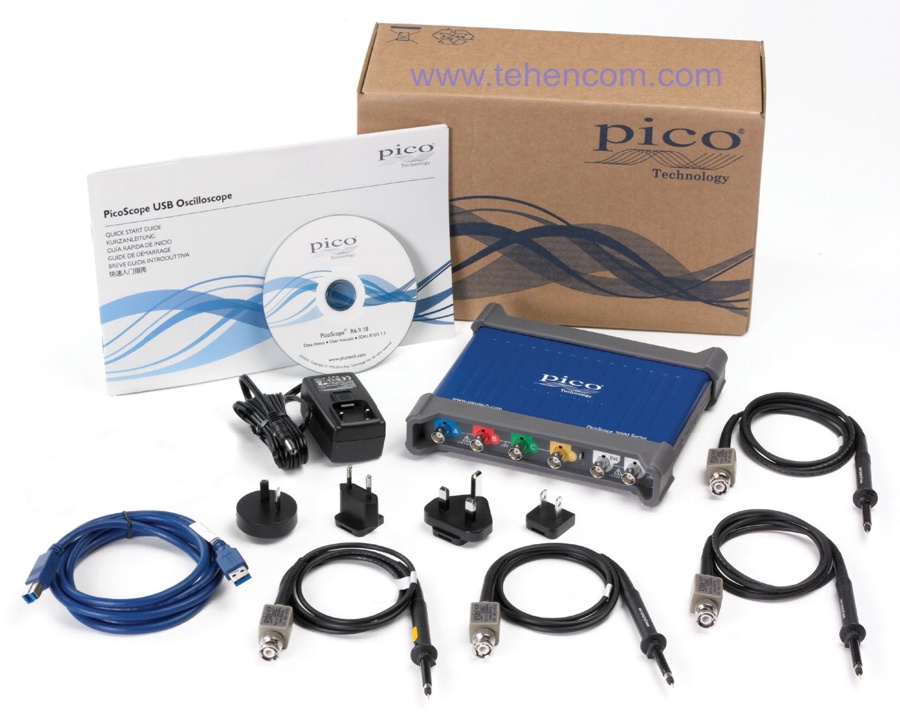
Options and Accessories for Pico Technology PicoScope 3000D Series Digital Oscilloscopes
Below is a list of recommended accessories that can be added to the PicoScope 3000D series USB oscilloscopes to enhance their functionality. For a complete list of options and accessories with a detailed description, see below on this page in the section Documentation.
| Accessory photo | Name and short description |
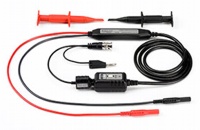
|
Pico Technology TA058 - active differential probe (50 MHz, 10:1) to measure voltages up to ±70 V (DC + peak AC) in the presence of common-mode voltage up to ±700 V (DC + peak AC) |
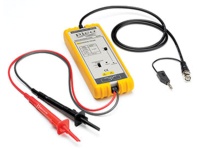
|
Pico Technology TA041 - active differential probe (25 MHz, 10:1 and 100:1) to measure voltages up to ±70 V (10:1 division) and up to ±700 V (100:1 division) in the presence of up to ±700 V (DC) common-mode voltage + peak AC) |
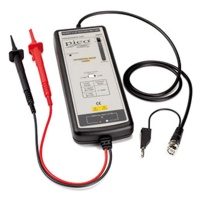
|
Pico Technology TA042 - Active differential probe (100 MHz, 100:1 and 1000:1) to measure voltages up to ±140 V (100:1 division) and up to ±1400 V (1000:1 division) in the presence of up to ±1400 V (DC) common-mode voltage + peak AC) |
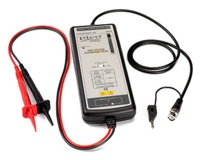
|
Pico Technology TA044 - active differential probe (70 MHz, 100:1 and 1000:1) to measure voltages up to ±700 V (100:1 division) and up to ±7000 V (1000:1 division) in the presence of up to ±7000 V (DC) common-mode voltage + peak AC) |
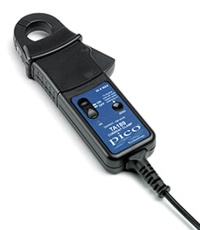
|
Pico Technology TA189 - high-precision current probe up to 30 Amp (DC + AC peak), ±1% accuracy, 100 kHz, BNC connector |
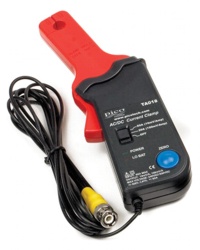
|
Pico Technology TA018 - current probe up to 60 Amp AC/DC, 20 kHz, two ranges (up to 20 A and up to 60 A), BNC connector |
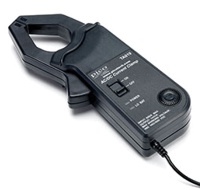
|
Pico Technology TA019 - current probe up to 600 Amp AC/DC, 400 Hz, BNC connector |
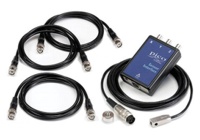
|
Pico Technology PP877 - three-axis accelerometer (X / Y / Z), ±5g, 350 Hz, three BNC connectors |
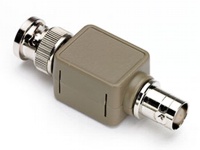
|
Pico Technology TA051 - 50 ohm termination (Terminator), 1 GHz, 1 W, BNC(m) - BNC(f), used to connect 50 ohm signal sources, such as radio antennas, to an oscilloscope with an input impedance of 1 MΩ |
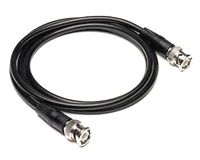
|
Pico Technology MI030 - connecting signal cable BNC(m) - BNC(m), 1.1 meters, used to connect signal sources with BNC output to the oscilloscope |
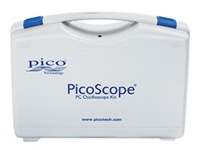
|
Pico Technology PP969 - a case for safe transportation and storage of oscilloscopes of the PicoScope 3000D series |
If you need technical advice on choosing the best accessory kit for your PicoScope 3000D USB oscilloscope or pricing information, just Contact us and we will be happy to answer your questions.
Documentation
This PDF documentation contains the most comprehensive description of USB oscilloscope capabilities. Pico Technology PicoScope 3000D series, their specifications and operating modes:
PicoScope 3000D USB Oscilloscope Description and Specifications (25 pages; 6 MB)
PicoScope 3000D USB Oscilloscopes User Manual (English) (30 pages; 2 MB)
PicoScope 3000D USB Oscilloscope Programming Guide (English) (161 pages; 2 MB)
PicoScope 6 User's Guide (English, 2020) (239 pages; 9 MB)
PicoScope 6 User Manual (in Russian, 2016) (216 pages; 7 MB)
And here you can find our tips and other useful information on this topic:
How to quickly choose an oscilloscope - selection criteria, typical applications and popular models
DPO digital phosphor technology in oscilloscopes - principle of operation, application examples
How to buy equipment cheaper - discounts, special prices, demo and used devices
To simplify the process of choosing a digital USB oscilloscope, you can use our experience and recommendations. We have over 20 years of practical supply experience and can immediately answer many questions about models, options, delivery times, prices and discounts. This will save your time and money. For this it's simple call us or write to us at Email and we will be happy to answer your questions.